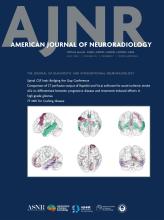We greatly appreciate and read with interest the opinion by Abruzzo et al. We understand the argument that a venous-predominant AVM (vpAVM) is not a true AVM in that hyperemic capillary blush is observed, suggesting that the parenchymal capillary bed with rapid transit time is involved in the circulation of the lesion. The lack of a definite nidus on DSA also supports their points. However, a number of case reports and series have addressed the resemblance of these lesions to true AVMs based on histologic similarity.1,2 Moreover, their angiographic and clinical features (early appearance of draining vein, various symptoms, and hemorrhage) are those of an AVM.
The nature of these lesions is not yet well-understood, and no definite terminology has been established. They are currently addressed with various terms such as atypical developmental venous anomaly (DVA), transitional venous anomaly, arterialized DVA, and DVA with an arteriovenous shunt. Whether AVM or not, the focus of our study was that arterial spin-labeling can distinguish DVA and vpAVM (or atypical DVA) without the patient having to undergo invasive DSA or the use of contrast agent. Because arterial spin-labeling is increasing in availability, we hope that our findings help readers recognize these rare disease entities in routine MR imaging clinical practice.
- © 2024 by American Journal of Neuroradiology












